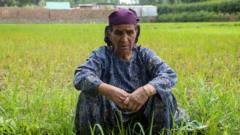With Kashmir gripped by an unprecedented heat crisis, farmers find themselves at the brink of despair as climate impacts intensify. The picturesque Himalayan region, known for its moderate climate, recently recorded alarmingly high temperatures, peaking at 37.4°C (99.32°F), a staggering 7°C above seasonal norms. Zaina Begum, a farmer in Pulwama district, stands by her paddy field, withering under the relentless sun, lamenting the months of failed rainfall. Although a brief shower offered glimmers of hope, it was ultimately too late to salvage her crops. “We have nothing left,” she confided.
The impact of the heatwave is palpable, with the valley experiencing its hottest June in half a century, driving local authorities to shut schools for a fortnight. Experts warn that even recent downpours may not provide lasting relief, and with predictions for even higher temperatures ahead, the local farming community is bracing for the worst.
In a region where paddy farming has been a tradition for decades, the erratic weather patterns have become increasingly detrimental. Mukhtar Ahmad, head of the Indian Meteorological department in Srinagar, has noted that the region has faced three scorching heatwaves thus far this season, exacerbating water shortages in rivers and streams.
In Bandipore, Ali Mohammad has shifted from cultivating rice to growing apples decades ago but now faces challenges even with this hardier crop. Despite requiring less water, his apple trees are wilting due to a lack of irrigation over the last two months.
Residents, unaccustomed to such extreme heat, report health concerns linked to the soaring temperatures. Parveez Ahmad, a local resident, was hospitalized after experiencing severe breathlessness, with doctors attributing his condition to the heat and humidity.
As environmental specialists attribute these dramatic changes to climate change, they warn of an ongoing trend that could disrupt the delicate balance of water, agriculture, and human health in the region. This is alarming in a locale that contributes minimally to global emissions yet bears the brunt of a crisis they had little role in creating.
The situation is further complicated by urbanization, with expansive concrete structures replacing natural landscapes, decreasing the region's inherent climate regulation capabilities. Reports indicate that Jammu and Kashmir lost nearly 0.39% of its total tree cover between 2001 and 2023 due to deforestation.
Despite the pressing challenges, local officials like Tanvir Sadiq assert that the government is committed to tackling climate issues, although critics argue that environmental concerns remain low on the political agenda. For vulnerable farmers like Zaina Begum, urgent and decisive action is critical. “Otherwise, we will be doomed,” she warns, underscoring the need for immediate solutions to secure a sustainable future for Kashmir.
The impact of the heatwave is palpable, with the valley experiencing its hottest June in half a century, driving local authorities to shut schools for a fortnight. Experts warn that even recent downpours may not provide lasting relief, and with predictions for even higher temperatures ahead, the local farming community is bracing for the worst.
In a region where paddy farming has been a tradition for decades, the erratic weather patterns have become increasingly detrimental. Mukhtar Ahmad, head of the Indian Meteorological department in Srinagar, has noted that the region has faced three scorching heatwaves thus far this season, exacerbating water shortages in rivers and streams.
In Bandipore, Ali Mohammad has shifted from cultivating rice to growing apples decades ago but now faces challenges even with this hardier crop. Despite requiring less water, his apple trees are wilting due to a lack of irrigation over the last two months.
Residents, unaccustomed to such extreme heat, report health concerns linked to the soaring temperatures. Parveez Ahmad, a local resident, was hospitalized after experiencing severe breathlessness, with doctors attributing his condition to the heat and humidity.
As environmental specialists attribute these dramatic changes to climate change, they warn of an ongoing trend that could disrupt the delicate balance of water, agriculture, and human health in the region. This is alarming in a locale that contributes minimally to global emissions yet bears the brunt of a crisis they had little role in creating.
The situation is further complicated by urbanization, with expansive concrete structures replacing natural landscapes, decreasing the region's inherent climate regulation capabilities. Reports indicate that Jammu and Kashmir lost nearly 0.39% of its total tree cover between 2001 and 2023 due to deforestation.
Despite the pressing challenges, local officials like Tanvir Sadiq assert that the government is committed to tackling climate issues, although critics argue that environmental concerns remain low on the political agenda. For vulnerable farmers like Zaina Begum, urgent and decisive action is critical. “Otherwise, we will be doomed,” she warns, underscoring the need for immediate solutions to secure a sustainable future for Kashmir.
















